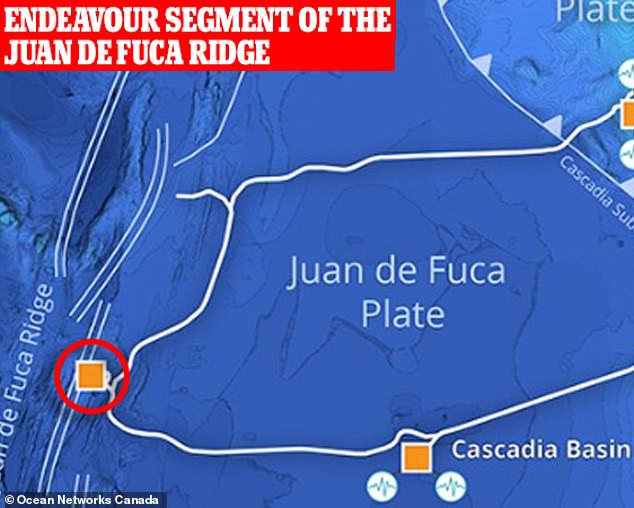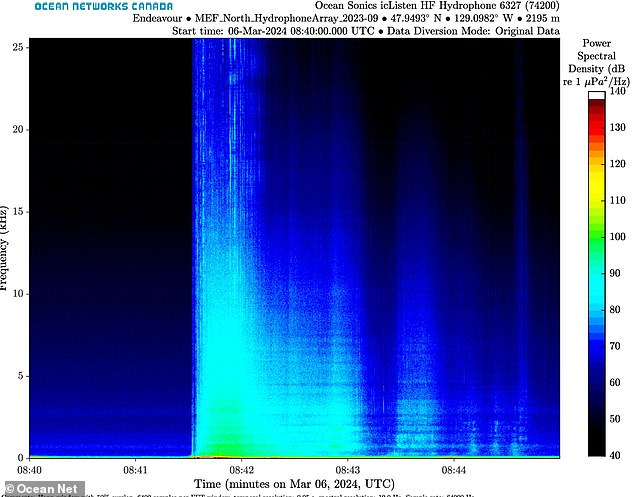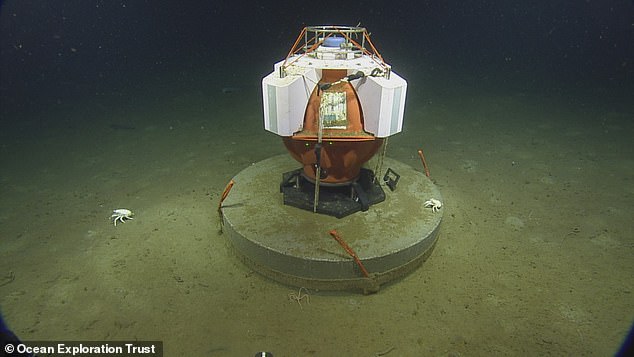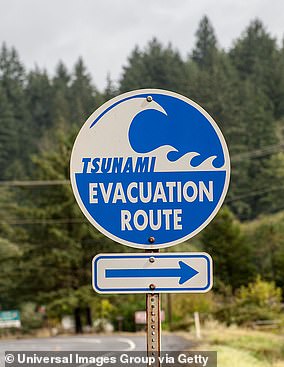Underwater volcano off the coast of the northwestern US could erupt within weeks as a 300-metre-long swathe is hit by a ‘large swarm’ of earthquakes
Scientists have discovered a ‘large swarm’ of earthquakes off the coast of Washington, reaching a rate of as many as 200 in one hour over one day.
University of Washington geologists said the earthquakes could cause the Juan de Ruca Ridge to erupt within a few weeks or years, but the effects are likely mild and unlikely to affect anyone on land.
The underwater volcano is located more than 16,000 feet below the Pacific Ocean and about 150 miles off the coast of Washington.
With more than a thousand small tremors detected in one day, this is the most activity seen at the site since 2005 – and researchers said the volcano could erupt soon.
This photo shows the seafloor in the Endeavor segment of the Juan de Fuca Ridge, the location of the recent ‘swarm’ of earthquakes
The team said data collected when the volcano erupted could reveal how the Earth’s crust was formed over time by cooled magma – but noted that this could happen in a few weeks or a few years.
On March 6, the group’s real-time monitoring network detected the earthquakes, which registered a magnitude of 4.1 – relatively mild compared to famously damaging earthquakes such as the 1906 San Francisco earthquake, which registered a magnitude of 7.9.
That earthquake and the devastating fires it caused killed approximately 3,000 people.
The ‘large swarm’ of earthquakes followed several days of increasingly frequent earthquakes, according to the US newspaper The Guardian Ocean Networks Canada (ONC), which collects the data so researchers can study it.
The spike indicated a possible “imminent magmatic rupture,” the research group reported.
A magmatic rift, which occurs when the Earth’s crust splits open for some reason and molten rock spills out, is a natural phenomenon that can form new ocean floor, according to Zoe Krauss, a doctoral candidate in marine seismology at the University of Washington .
In the case of the Juan de Fuca Ridge, this rupture will be the result of two plates pulling apart, creating a giant crack that allows magma to flow out at a temperature of about 1,500 degrees Fahrenheit.
Officials at ONC have emphasized that the effects will be mild and localized, and that residents on land are extremely unlikely to feel the earthquake.
This is also unlikely to lead to tsunami activity, as a tsunami is caused by a different type of tectonic plate boundary movement: pushing and sliding, rather than pulling apart.
‘Nobody has to worry about this big swarm of earthquakes. They are located far from the coast and do not cause any danger. On the contrary, the data is exciting for the scientific community and certainly not threatening,” said Kate Moran, ONC president and CEO, in the ONC statement.
The impending volcanic eruption has scientists excited because it will provide a real-time glimpse into how Earth formed.
As lava flows from a crack in the Earth’s crust, it will warm the water around it, and the ocean will probably even fizz like soda.

Geologists from the University of Washington observed the earthquakes this month near the Endeavor segment of the Juan de Ruca Ridge, which lies more than 16,000 feet beneath the Pacific Ocean and about 150 miles off the coast of Washington.

This spectrogram shows all the earthquakes generated in just a few minutes on March 6. It is generated from audio recording data that captures seismic activity.
When the lava hardens, a new layer of seafloor will form – an example of what it was like when our planet first formed its crust.
Scientists have been studying the site for almost 30 years.
Exploring the unique seafloor vents on the Juan de Fuca Ridge provides unique opportunities to study how crustal war first arose, as well as the strange marine life that exists around the site.
But this will be the first time they have been able to observe a volcanic eruption with sound recording equipment and temperature probes.

This Fetch device monitors seismic activity on the seafloor as part of ONC’s NEPTUNE observatory. Some deep-sea lobsters investigate
These tools will complement the seismographs that have been at the site since the last submarine eruption from 1999 to 2005.
OCN researchers have seen an increase in earthquake activity at the monitoring site near the Endeavor segment.
“It’s about 10 times as active as normal,” says Jesse Hutchinson, a junior staff scientist at ONC, based at the University of Victoria.
Hutchinson and his colleagues had detected more than 2,000 earthquakes in one day, he said told CBC.
Researchers expect this event to repeat about every 20 years, OCN officials said.
ONC operates its vast NEPTUNE monitoring network that tracks activity across the area, including seafloor tilt, seismic activity and the chemical composition coming from ‘black smoker’ vents that spew black clouds of hydrogen sulphide – food for the chemosynthetic worms that live in near the ventilation openings.
This undersea observatory allows scientists to predict when a volcanic eruption is coming.
“We can use earthquake activity to monitor the level of accumulated stress in the Endeavor segment in real time using seismic data from Ocean Networks Canada. More earthquakes mean more stress buildup,” Krauss said. “The NEPTUNE Observatory dataset has allowed us to observe a significant increase in the number of earthquakes in recent years.”
And the instruments allow scientists to monitor not only changes over time, but also in near real time during an event like a volcanic eruption.
During the last eruption, the only tools available were seismometers to detect tremors.
‘By having a whole range of instruments, as opposed to just seismometers, we can immediately see what else is going on, such as temperature changes in a black smoker, or instruments starting to tilt, or listening through hydrophones for hissing or tumbling of lava is breaking the seabed if that were to happen,” said Martin Scherwath, senior scientist at ONC.
Unfortunately for marine life around the eruption site, magma fractures can harden existing habitats.

